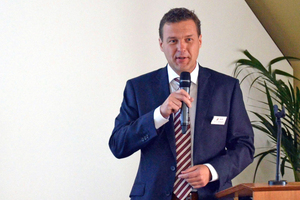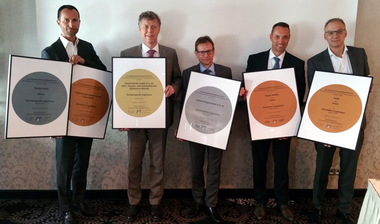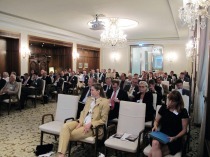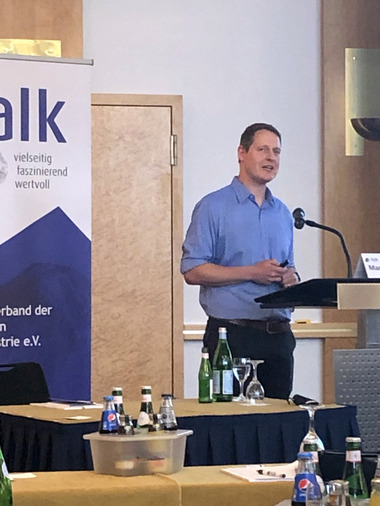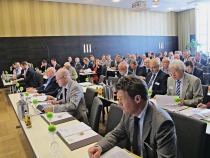Stable market for the German lime industry in 2017
At the Association’s annual meeting in Lindau, BVK President Dr Kai Schaefer analysed current political and economic developments. He addressed the central themes for the forthcoming years: securing the future supply of raw materials and reduction of CO2 emissions by 2050.
This year’s annual meeting of the German, Austrian and Swiss lime industry took place in Lindau.
The Association’s President Dr Kai Schaefer, a member of the management team at Schaefer Kalk GmbH & Co KG, Diez, took a look at the German government’s coalition agreement. The German lime industry expressly welcomes the continuation of the “Future of Industry” alliance and the corresponding industry dialogues, the drawing up of a skilled employees immigration act and skilled employee initiative and especially the anchoring of a long-term investment and planning reliability for the extraction of domestic raw materials in the coalition agreement. The industry continues to support the coalition’s pledge to guarantee the competitiveness – especially of the energy-intensive industries and integrated value creation chains -as well as the assurance of extensive carbon leakage protection. “That the EU ETS is to be strengthened as a climate policy leading instrument also meets our demand with which we, together in the alliance of energy-intensive industries, have repeatedly approached the policy makers,“ said Dr Schaefer. Schaefer sees hidden risks for the German lime industry in different measures for implementation of the Climate Protection Plan 2050 with a Climate Protection Act.
In European and global politics there were imponderables associated with considerable economic dangers, especially the anticipated financial collapse of Italy, Brexit, Russia’s politics, which was also creating uncertainties in energy issues, as well as the politics of the American President against open markets and free trade.
The BVK President observed that the lime market was stable in 2017. If, however, you looked at Germany’s 2.2 % economic growth, then you had to conclude that the trend of past years had been perpetuated. “We no longer profit 1:1 from the overall economic development,” said Schaefer.
He then presented the current figures for the lime industry. With regard to unburnt lime products, the BVK represents around 15 % of the German lime industry, for burnt lime products almost 100 %.
Market sales for unburnt lime products totalled around 18.3 million t in 2017, an increase of 1.2 % on the previous year.
The main buyer of unburnt products from the members of the BVK is the construction industry. In this user segment, in 2017 around 7.1 million t were supplied. The result for 2017 is therefore significantly better (+3.7 %) than in the year previously.
Unchanged are the supplies of unburnt lime products for environmental protection applications. This consumer segment has enjoyed stable development at around 2.1 million t.
The supplies of unburnt products for industrial applications declined slightly (-1.2 %) compared to 2016. Supplies to the iron and steel industry reached over 3 million t.
The sales of burnt products in 2017 remained almost constant.
Overall, the members of the BVK were able to sell around 6.3 million t burnt products. That corresponds to a slight increase of 0.1 %.
For the main buyer of the lime products, the iron and steel industry, slight growth of 0.7 % to more than 2.2 million t can be reported. Industrial sales overall have improved slightly compared to the previous year (+1.1 %).
Supplies for environmental protection applications are still clearly in decline. Overall for this segment, only around 1.2 million t were sold. This corresponds to a decline of almost 5 %. For air purification, only 770 000 t were supplied. That corresponds to a loss of 8.4 %. Increasingly, the decline in power generation from lignite is playing a crucial role.
On the other hand, the German lime industry can be satisfied with the supplies to the construction materials industry. Overall, a plus of almost 3 % could be achieved. That corresponds to a supply volume of more than 900 000 t, the main part of these supplies being needed for the production of wall construction materials.
Disproportionately positive was the development in the supply of burnt lime products for use in road construction and surfacing. In this segment, 381 000 t were consumed (a plus of almost 9 %).
Schaefer emphasized the fundamental significance of mineral resources for industrial value creation and maintaining prosperity. The energy turnaround – supported by the vast majority of the population – could not be realized without mineral resources from Germany.
Sand and gravel were already scarce, the demand was currently greater than the approved extraction. “To put it bluntly, in Germany we have no lack of mineral resource deposits. We have only a lack of approved extraction areas. Planning, environmental and conservation law is becoming increasingly complex and requires protracted and costly licensing procedures. Unfortunately, we have also observed that many conservation associations and local action groups only stand up for their individual interests,” the BVK President pointed out.
Another central theme required additional efforts, the reduction of CO2 emissions. The industry had to step up efforts on its own initiatives and solution-oriented approaches.
Focuses of Association work
At the meeting, the CEO of the Federal Association, Martin Ogilvie, presented the annual report 2017/2018 and explained the work done in the past business year as well as the current core fields of activity. He went into the networking of the Association. For instance, in a network with the BDI, the study “Climate Paths for Germany“ has been compiled. In three scenarios, the study calculates possible ways to achieve the German government’s climate goals – 80 % or 95 % CO2 reduction by 2050 compared with 1990 and elucidated the Association measures and costs.
In addition, Ogilvie presented the biodiversity database for the non-metallic minerals industry, with the aim of obtaining a nationwide overview on biodiversity at the extraction sites.
Finally, he discussed pre-competitive collective research, which functions as an important innovation driver and presented the ongoing project of CO2 scrubbing with limestone flour at the Wilhelmshafen power plant.
Flandersbach plant again winner of the occupational safety competition
The Vice-President of the Association of the German Lime Industry, Dr Burkhard Naffin, paid tribute to the winner of this year’s occupational safety competition for the industry. The competition now held for more than 30 years by the BVK certainly has an important function. The aim is to motivate companies to maximize safety at the workplace and to encourage employees to adopt safety-conscious behaviour in the workplace.
The golden certificate this year goes to last year’s winner, the Flandersbach plant operated by the Lhoist Group.
The next Annual Meeting will take place in Leipzig from 13.06.-14.06.2019.

